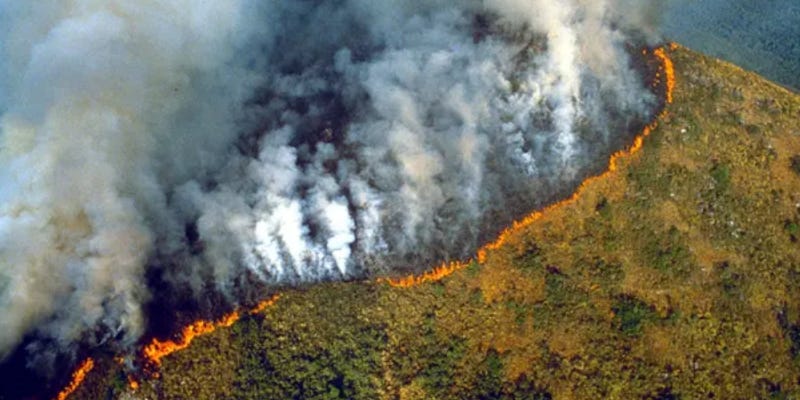Climate tipping point? The Amazon faces intense droughts and fires again this year
According to NASA, the Amazon is drier at the start of this year’s dry season than any year since 2002. The reason is reduced rainfall during the wet season because of El Niño. The result could be intense fires in the Amazon later this year.
Doug Morton is an Earth scientist at NASA’s Goddard Space Flight Center. He helped create the Amazon fire forecast. “Severe drought conditions at the start of the dry season set the stage for extreme fire risk in 2016 across the southern Amazon,” Morton says in a statement on NASA’s website.
Jim Randerson, a scientist at University of California, Irvine also worked on the fire forecast. He explains that,
“When trees have less moisture to draw upon at the beginning of the dry season, they become more vulnerable to fire, and evaporate less water into the atmosphere. This puts millions of trees under stress and lowers humidity across the region, allowing fires to grow bigger than they normally would.”
The Amazon faced “one in a century” droughts in 2005 and 2010. This year’s El Niño-driven conditions are far drier than both of those years. So far this year, the Amazon has seen more fires than in 2005 and 2010.
The fire forecast has produced a graphic illustrating the risk of severe fire activity on a scale of zero to 100 in July, August and September:
The figure shows fire season severity indices (0-100) in six states in Brazil (Acre, Amazonas, Maranhao, Mato Grosso, Para and Rondonia), three departments in Bolivia (El Beni, Pando, and Santa Cruz), and one country (Peru).
On the graphic, green indicate below average predictions of fire activity, and orange and red indicate above average activity.
REDD’s double whammy
The droughts and fires in the Amazon are bad news for the world’s climate. Rainforests store huge amounts of carbon, which is released to the atmosphere when the forest burns.
During the droughts in 2005 and 2010, the Amazon turned from a carbon sink to a source of carbon. The 2005 drought released between 1.2 and 1.6 billion tons of carbon to the atmosphere. The fires in Indonesia last year released 1.75 billion tons of carbon.
Burning rainforest is bad enough. But REDD gives us a double whammy if the carbon no longer stored in the forest has been traded against continued emissions from burning fossil fuels elsewhere.
Playing Russian roulette with the Amazon
In February 2011, scientists produced a report titled “The 2010 Amazon Drought,” published in Nature. In it, they argued that the two recent droughts show a mechanism by which tropical forests in South America “can shift from buffering the increase in atmospheric carbon dioxide to accelerating it.”
In a press release, the lead author of the paper, Simon Lewis of Leeds University, made clear that the implications of droughts in the Amazon are huge:
“Two unusual and extreme droughts occurring within a decade may largely offset the carbon absorbed by intact Amazon forests during that time. If events like this happen more often, the Amazon rainforest would reach a point where it shifts from being a valuable carbon sink slowing climate change, to a major source of greenhouse gasses that could speed it up.
“Considerable uncertainty remains surrounding the impacts of climate change on the Amazon. This new research adds to a body of evidence suggesting that severe droughts will become more frequent leading to important consequences for Amazonian forests.
“If greenhouse gas emissions contribute to Amazon droughts that in turn cause forests to release carbon, this feedback loop would be extremely concerning. Put more starkly, current emissions pathways risk playing Russian roulette with the world’s largest rainforest.”
In March 2015, Nature published another report about the Amazon: “Long-term decline of the Amazon carbon sink.” The study is the most extensive land-based study of the Amazon to date. The 30-year survey of trees in the Amazon involved a team of nearly 100 researchers, led by Leeds University. The authors write:
While this analysis confirms that Amazon forests have acted as a long-term net biomass sink, we find a long-term decreasing trend of carbon accumulation. Rates of net increase in above-ground biomass declined by one-third during the past decade compared to the 1990s.
What does this mean for REDD?
It would be lovely to believe that if we could only save the rainforest, we could trade carbon credits, and carry on polluting. But if the Amazon is going up in smoke, which the evidence shows it is doing disturbingly frequently, we need to rethink. Urgently.
Storing carbon in forests facing frequent extreme droughts, and that are turning from sinks to sources of carbon, makes no sense whatsoever. Continuing to burn fossil fuels turns out to be one of the main drivers of emissions from forests.
Of course we should reduce emissions from deforestation and forest degradation. But instead of trading REDD credits against continued pollution, we need to leave fossil fuels in the ground.






